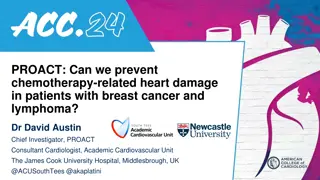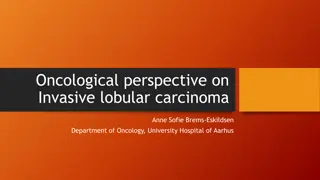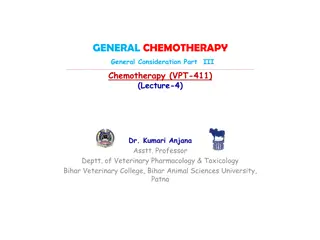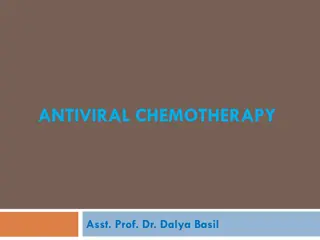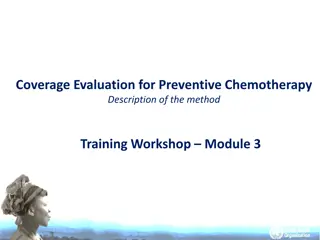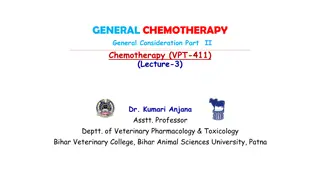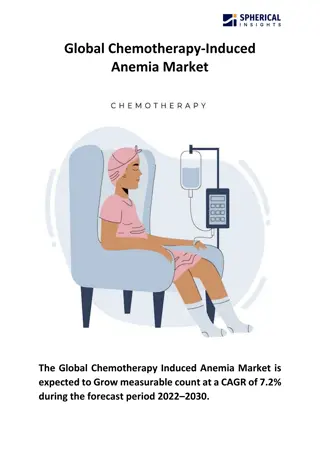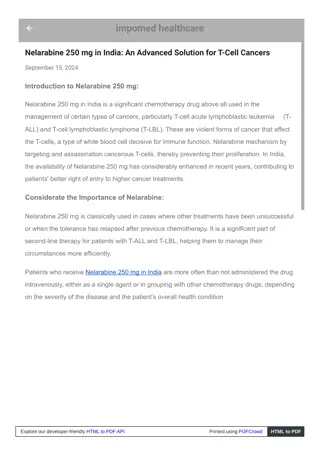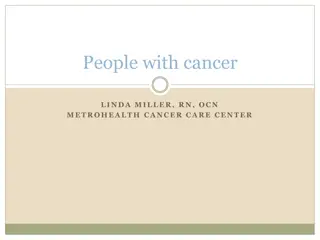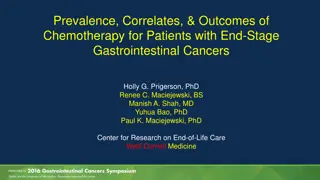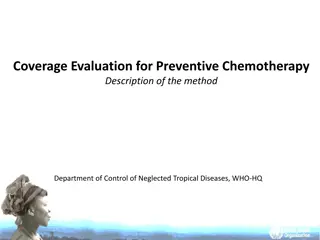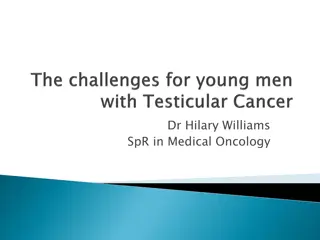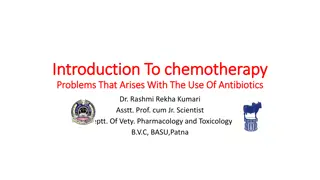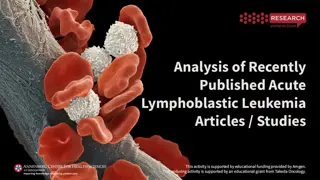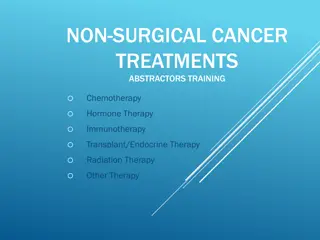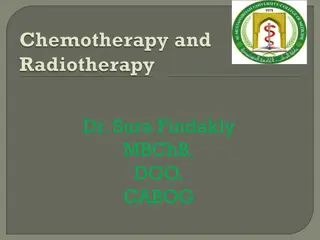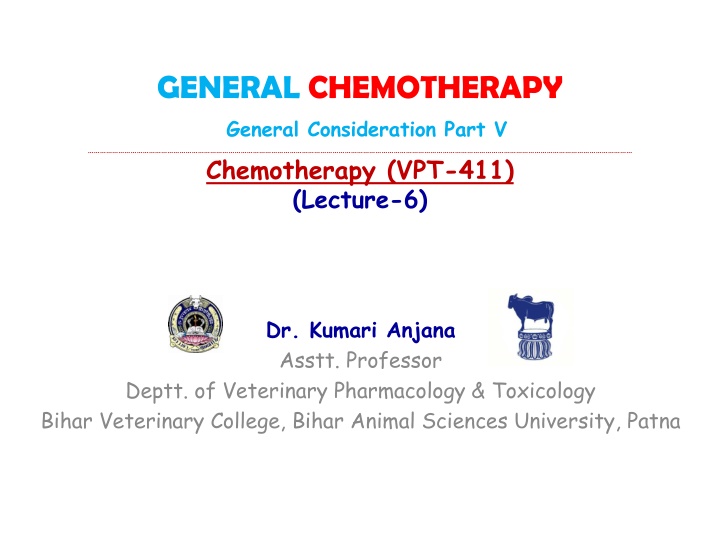
Veterinary Chemotherapy Considerations: Toxicity, Resistance, and Reactions
Explore the key considerations in veterinary chemotherapy including local irritancy, systemic toxicity, hypersensitivity reactions, drug resistance, and natural microbial resistance. Understand the implications of these factors in administering treatment to animals effectively.
Download Presentation

Please find below an Image/Link to download the presentation.
The content on the website is provided AS IS for your information and personal use only. It may not be sold, licensed, or shared on other websites without obtaining consent from the author. If you encounter any issues during the download, it is possible that the publisher has removed the file from their server.
You are allowed to download the files provided on this website for personal or commercial use, subject to the condition that they are used lawfully. All files are the property of their respective owners.
The content on the website is provided AS IS for your information and personal use only. It may not be sold, licensed, or shared on other websites without obtaining consent from the author.
E N D
Presentation Transcript
GENERAL CHEMOTHERAPY General Consideration Part V Chemotherapy (VPT-411) (Lecture-6) Dr. Kumari Anjana Asstt. Professor Deptt. of Veterinary Pharmacology & Toxicology Bihar Veterinary College, Bihar Animal Sciences University, Patna
Content of the chapter Toxicity- Local irritancy & Systemic toxicity Hypersensitivity reaction Drug resistance Superinfection Nutritional Deficiencies Masking of an infection
Local irritancy Exerted at the site of administration. Gastric formation at the site of i.m. injection, thrombophlebitis of the injected vein are the complications. irritation, pain and abscess Practically erythromycin, cephalosporins irritants. all AMAs, especially certain tetracyclines, and chloramphenicol are
Systemic toxicity High therapeutic index doses up to 100-fold range may be given without apparent damage to host cells. These include penicillins, some cephalosporin's and erythromycin. Lower therapeutic index doses have to be individualized and toxicity watched for, e.g.: Aminoglycosides : 8th cranial nerve and kidney toxicity. Tetracyclines : liver and kidney damage, antianabolic effect. Chloramphenicol : bone marrow depression. Very low therapeutic index use is highly restricted to conditions where no suitable alternative is available, e.g. : Polymyxin B : neurological and renal toxicity. Vancomycin : hearing loss, kidney damage. Amphotericin B : kidney, bone marrow and neurological
Hypersensitivity reactions Practically all AMAs are capable of causing hypersensitivity reactions. These are unpredictable and unrelated to dose. The whole range of reactions from rashes to anaphylactic shock can be produced. The more commonly involved AMAs are penicillins, cephalosporins, fluoroquinolones. sulfonamides,
Drug resistance It refers to unresponsiveness of a microorganism to an AMA, and is akin to the phenomenon of tolerance seen in higher organisms. Two type Natural resistance Acquired resistance
Natural resistance Some microbes have always been resistant to certain AMAs. They lack the metabolic process or the target site which is affected by the particular drug. This is generally a group or species characteristic. e.g. gram-negative bacilli are normallyunaffected by penicillin G, M. tuberculosis is insensitive to tetracyclines. No significant clinical problem.
Acquired resistance It is the development of resistance by an organism (which was sensitive before) due to the use of an AMA over a period of time. This can happen with any microbe and is a major clinical problem. However, development of resistance is dependent on the microorganism as well as the drug. Some bacteria are notorious for rapid acquisition of resistance, e.g. staphylococci, coliforms, tubercle bacilli. Others like Strep. pyogenes and spirochetes have not developed significant resistance to penicillin.
Development of resistance Resistance may be developed by mutation or gene transfer
Mutation Mutation is a stable and heritable genetic change that occurs spontaneously and randomly among microorganisms. It is not induced by the AMA. Any sensitive population of a microbe contains a few mutant cells concentration of the AMA for inhibition. which require higher e.g. when a single anti-tubercular drug is used.
Mutation and resistance may be: Single step: A single gene mutation may confer high degree of resistance; emerges rapidly, e.g. enterococci to streptomycin, E. coli and Staphylococci to rifampin. Multistep: A number of gene modifications are involved; sensitivity decreases gradually in a stepwise manner. eg. Resistance to erythromycin, tetracycline and chloramphenicol is developed by many organisms.
Gene transfer Gene transfer (infectious resistance) from one organism to another can occur by: Conjugation Transduction Transformation
Conjugation Sexual contact through the formation of a bridge or sex pilus is common among gram- negative bacilli of the same or another species. This may involve chromosomal or extrachromosomal (plasmid) DNA. The gene carrying the resistance or R factor is transferred only if another resistance transfer factor (RTF) is also present.
Contd It frequently occurs in the colon where a large variety of gram-negative bacilli come in close contact. Even transfer R factor to pathogenic organisms, which may become contamination of food or water. nonpathogenic organisms may widespread by
Chloramphenicol resistance of typhoid bacilli, streptomycin resistance of E. coli, penicillin resistance of Haemophilus and gonococci. Multidrug conjugation. resistance has occurred by It is a very important mechanism of horizontal transmission of resistance.
Fig: Transformation, Transduction and Conjugation Source : Google image
Transduction It is the transfer of gene carrying resistance through the agency of a bacteriophage. The R factor is taken up by the phage and delivered to another bacterium which it infects. Many Staph. aureus strains have acquired resistance by transduction. Certain instances of penicillin, erythromycin and chloramphenicol resistance have been found to be phage mediated.
Transformation A resistant bacterium may release the resistance carrying DNA into the medium and this may be imbibed by another sensitive organism becoming unresponsive to the drug. This mechanism is probably not clinically significant except isolated instances of pneumococcal resistance to penicillin G due to altered penicillin binding protein, and some other cases.
Resistant organisms Resistant organisms can broadly be of the following three types: Drug tolerant Drug destroying Drug impermeable
Drug tolerant Loss of affinity of target biomolecule of the microorganism for a particular AMA. e.g., certain penicillin pneumococcal strains penicillin binding proteins. resistant altered have
Drug destroying Resistant microorganism elaborate an enzyme which inactivate the drug. Beta lactamase for lactam antibiotics, Acetyl transferase chloramphenicol, Kinases inactivates Aminoglycosides. which inactivate
Drug impermeable Many hydrophilic antibiotics gain access into the bacterial cell through specific channel formed by protein called porins or need specific transport mechanism. These may be lost by the resistant strain. Bacteria may acquire plasmid directed efflux protein in their cell membrane.
Cross resistance Acquisition of resistance to one AMA conferring resistance to another AMA, to which the organism has not been exposed, is called cross resistance. This is more commonly seen between chemically or mechanistically related drugs. e.g. resistance to one sulfonamide means resistance to all others, and resistance to one tetracycline means insensitivity to all others.
Complete cross resistance or Two way cross resistance Neomycin Kanamycin Partial cross resistance or One way cross resistance Gentamicin Kanamycin Streptomycin
Prevention of drug resistance No indiscriminate and inadequate or unduly prolonged use of AMAs should be made. Prefer spectrum) AMA whenever possible. rapid acting and selective (narrow Use combination of AMAs whenever prolonged therapy is undertaken, e.g. tuberculosis, SABE. Infection by organism notorious for developing resistance, e.g. Staph tuberculosis, Proteus etc must be treated extensively. aureus, E. coli, M.
Superinfection (Superinfection) This refers to the appearance of a new infection as a result of antimicrobial therapy. Use of most AMAs causes some alteration in the normal microbial flora of the body. The normal flora contributes to host defense by elaborating substances called bacteriocins which inhibit pathogenic organisms.
Nutritional deficiencies Some of the B complex group of vitamins and vit. K synthesized by the intestinal flora is utilized by man. Prolonged use of antimicrobials which alter this flora may result in vitamin deficiencies. Neomycin causes morphological abnormalities in the intestinal mucosa steatorrhoea and malabsorption syndrome can occur.
Masking of an infection A short course of an AMA may be sufficient to treat one infection but only briefly suppress another one contacted concurrently. The other infection will be masked initially, only to manifest later in a severe form. Eg: Tuberculosis masked by a short course of streptomycin given for trivial respiratory infection.

